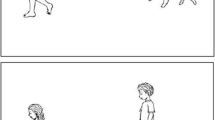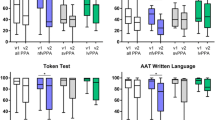Abstract
Primary progressive aphasia (PPA) is a neurodegenerative disease characterised by a progressive decline in language and speech as the first clinical manifestation, which mostly spares other cognitive functions. However, the linguistic impairment of PPA shows different features than that resulting from cerebrovascular diseases. The major difference between the linguistic manifestations of PPA and the traditional classification of aphasias has led to the development of new, more specific methods of language assessment. Among the currently available tools, there has been great interest in the Progressive Aphasia Severity Scale (PASS). This quick and easy-to-use clinical tool allows to collect significant information from caregivers about the communicative, linguistic, and functional difficulties of patients affected by PPA. In addition to monitoring the severity and progression of deficits in 13 different language domains, this scale integrates the classic “clinically reported” assessment with a “caregiver-reported” analysis of the daily experience of the patient, which provides a better understanding of how the disease affects the quality of life of both the patient and the caregiver. In the present contribution, the PASS was translated and adapted into Italian according to the international guidelines for the cross-cultural adaptation of self-report measures. This version of the PASS can help clinicians and researchers in the diagnosis of PPA in Italian clinical populations. Furthermore, it could be particularly useful for the long-term evaluation of the disease, in order to monitor its evolution, and might represent an optimal means to verify the efficacy of speech/language therapy in delaying the progression of the disease.
Similar content being viewed by others
Data availability
Supplementary material (including the instruction manual, questionnaire, and clinician’s worksheet) will be made available upon request to the corresponding author.
References
Mesulam MM (1982) Slowly progressive aphasia without generalized dementia. Ann Neurol 11:592–598. https://doi.org/10.1002/(ISSN)1531-8249
Mesulam MM (2007) Primary progressive aphasia: a 25-year retrospective. Alzheimer Dis Assoc Disord 21:S8–S11. https://doi.org/10.1097/WAD.0b013e31815bf7e1
Grossman M (2018) Linguistic Aspects of Primary Progressive Aphasia. Annu Rev Linguist 4:377–403. https://doi.org/10.1146/annurev-linguistics-011516-034253
Mesulam MM (2016) Primary progressive aphasia and the left hemisphere language network. Dement Neurocogn Disord 15:93–102. https://doi.org/10.12779/dnd.2016.15.4.93
Mesulam MM, Rogalski EJ, Wieneke C, Hurley RS, Geula C, Bigio EH, Thompson CK, Weintraub S (2014) Primary progressive aphasia and the evolving neurology of the language network. Nat Rev Neurol 10:554–569. https://doi.org/10.1038/nrneurol.2014.159
Gorno-Tempini ML, Hillis AE, Weintraub S, Kertesz A, Mendez M, Cappa SF, Ogar JM, Rohrer JD, Black S, Boeve BF, Manes F, Dronkers NF, Vandenberghe R, Rascovsky K, Patterson K, Miller BL, Knopman DS, Hodges JR, Mesulam MM, Grossman M (2011) Classification of primary progressive aphasia and its variants. Neurology 76:1006–1014. https://doi.org/10.1212/WNL.0b013e31821103e6
Montembeault M, Brambati SM, Gorno-Tempini ML, Migliaccio R (2018) Clinical, anatomical, and pathological features in the three variants of primary progressive. Front Neurol 9:692. https://doi.org/10.3389/fneur.2018.00692
Bonakdarpour B, Rogalski EJ, Wang A, Sridhar J, Mesulam MM, Hurley RS (2017) Functional Connectivity is Reduced in Early-stage Primary Progressive Aphasia When Atrophy is not Prominent. Alzheimer Dis Assoc Disord 31:101–106. https://doi.org/10.1097/wad.0000000000000193
Catani M, Piccirilli M, Cherubini A, Tarducci R, Sciarma T, Gobbi G, Pelliccioli G, Petrillo SM, Senin U, Mecocci P (2003) Axonal injury within language network in primary progressive aphasia. Ann Neurol 53:242–247. https://doi.org/10.1002/ana.10445
Gorno-Tempini ML, Dronkers NF, Rankin KP, Ogar JM, Phengrasamy L, Rosen HJ, Johnson JK, Weiner MW, Miller BL (2004) Cognition and anatomy in three variants of primary progressive aphasia. Ann Neurol 55:335–346. https://doi.org/10.1002/ana.10825
Rogalski E, Cobia D, Harrison TM, Wieneke C, Weintraub S, Mesulam MM (2011) Progression of language decline and cortical atrophy in subtypes of primary progressive aphasia. Neurology 76:1804–1810. https://doi.org/10.1212/WNL.0b013e31821ccd3c
Mesulam M, Wieneke C, Rogalski E, Cobia D, Thompson C, Weintraub S (2009) Quantitative template for subtyping primary progressive aphasia. Arch Neurol 66:1545–1551. https://doi.org/10.1001/archneurol.2009.288
Mesulam MM, Weintraub S (2014) Is it time to revisit the classification guidelines for primary progressive aphasia? Neurology 82:1108–1109. https://doi.org/10.1212/WNL.0000000000000272
Sapolsky D, Domoto-Reilly K, Negreira A, Brickhouse M, McGinnis S, Dickerson B (2011) Monitoring progression of primary progressive aphasia: current approaches and future directions. Neurodegenerative Disease Management 1:43–55
Canu E, Agosta F, Imperiale F, Ferraro PM, Fontana A, Magnani G, Mesulam MM, Thompson CK, Weintraub S, Moro A, Cappa SF, Filippi M (2019) Northwestern Anagram Test-Italian (Nat-I) for primary progressive aphasia. Cortex 119:497–510. https://doi.org/10.1016/j.cortex.2019.08.007
Catricalà E, Gobbi E, Battista P, Miozzo A, Polito C, Boschi V, Esposito V, Cuoco S, Barone P, Sorbi S, Cappa SF, Garrard P (2017) SAND: a Screening for Aphasia in NeuroDegeneration. Development and normative data. Neurol Sci 38:1469–1483. https://doi.org/10.1007/s10072-017-3001-y
Epelbaum S, Saade YM, Flamand Roze C, Roze E, Ferrieux S, Arbizu C, Nogues M, Azuar C, Dubois B, Tezenas du Montcel S, Teichmann M (2021) A reliable and rapid language tool for the diagnosis, classification, and follow-up of primary progressive aphasia variants. Front Neurol 11:571657. https://doi.org/10.3389/fneur.2020.571657
Patel N, Peterson KA, Ralph ML, Rowe JB, Patterson K, Cappa S, Ingram R, Garrard P (2020) The Mini Linguistic State Examination (MLSE): a standardised tool to classify and monitor primary progressive aphasia. Alzheimer’s Dement 16:e040853. https://doi.org/10.1002/alz.040853
Savage S, Hsieh S, Leslie F, Foxe D, Piguet O, Hodges JR (2013) Distinguishing subtypes in primary progressive aphasia: application of the Sydney language battery. Dement Geriatr Cogn Disord 35:208–218. https://doi.org/10.1159/000346389
Semler E, Anderl-Straub S, Uttner I, Diehl-Schmid J, Danek A, Einsiedler B, Fassbender K, Fliessbach K, Huppertz H-J, Jahn H, Kornhuber J, Landwehrmeyer B, Lauer M, Muche R, Prudlo J, Schneider A, Schroeter ML, Ludolph AC, Otto M, for the FTLD consortium (2018) A language-based sum score for the course and therapeutic intervention in primary progressive aphasia. Alzheimers Res Ther 10:41. https://doi.org/10.1186/s13195-018-0345-3
Battista P, Miozzo A, Piccininni M, Catricalà E, Capozzo R, Tortelli R, Padovani A, Cappa SF, Logroscino G (2017) Primary progressive aphasia: a review of neuropsychological tests for the assessment of speech and language disorders. Aphasiology 31:1359–1378. https://doi.org/10.1080/02687038.2017.1378799
Henry ML, Grasso SM (2018) Assessment of individuals with primary progressive aphasia. Semin Speech Lang 39:231–241. https://doi.org/10.1055/s-0038-1660782
Sapolsky D, Domoto-Reilly K, Dickerson BC (2014) Use of the Progressive Aphasia Severity Scale (PASS) in monitoring speech and language status in PPA. Aphasiology 28:993–1003. https://doi.org/10.1080/02687038.2014.931563
Beaton DE, Bombardier C, Guillemin F, Ferraz MB (2000) Guidelines for the process of cross-cultural adaptation of self-report measures. Spine 25:3186–3191. https://doi.org/10.1097/00007632-200012150-00014
Guillemin F, Bombardier C, Beaton D (1993) Cross-cultural adaptation of health related quality of life measures: literature review and proposed guidelines. J Clin Epidemiol 46:1417–1432. https://doi.org/10.1016/0895-4356(93)90142-n
Occhigrossi C, Lambro B, Petrillo SM, Piccirilli M (2018) Validazione transculturale in Lingua Italiana del “Progressive Aphasia Severity Scale (PASS) Questionnaire”. Abstract Book 13a Conferenza Nazionale GIMBE, p 134
Hendricson WD, Russell IJ, Prihoda TJ, Jacobson JM, Rogan A, Bishop GD, Castillo R (1989) Development and initial validation of a dual-language English-Spanish format for the arthritis impact measurement scales. Arthritis Rheum 32:1153–1159. https://doi.org/10.1002/anr.1780320915
Mesulam MM (2003) Primary progressive aphasia—a language-based dementia. N Engl J Med 349:1535–1542. https://doi.org/10.1056/NEJMra022435
Ellis-Smith C, Evans CJ, Bone AE, Henson LA, Dzingina M, Kane PM, Higginson IJ, Daveson BA, BuildCARE (2016) Measures to assess commonly experienced symptoms for people with dementia in long-term care settings: a systematic review. BMC Med 14:38. https://doi.org/10.1186/s12916-016-0582-x
Myrberg K, Hydèn LC, Samuelsson C (2018) Different approaches in aphasia assessments: a comparison between test and everyday conversations. Aphasiology 32:417–435. https://doi.org/10.1080/02687038.2017.1366416
Engel GL (1977) The need for a new medical model. A challenge for biomedicine. Science 196:129–136
Sapolsky D, Bakkour A, Negreira A, Nalipinski P, Weintraub S, Mesulam MM, Caplan D, Dickerson BC (2010) Cortical neuroanatomic correlates of symptom severity in primary progressive aphasia. Neurology 75:358–366. https://doi.org/10.1212/WNL.0b013e3181ea15e8
Jokel R, Kielar A, Anderson ND, Black SE, Rochon E, Graham S, Freedman M, Tang-Wai DF (2016) Behavioural and neuroimaging changes after naming therapy for semantic variant primary progressive aphasia. Neuropsychologia 89:191–216. https://doi.org/10.1016/j.neuropsychologia.2016.06.009
Meyer AM, Tippett DC, Friedman RB (2018) Prophylaxis and remediation of anomia in the semantic and logopenic variants of primary progressive aphasia. Neuropsychol Rehabil 28:352–368. https://doi.org/10.1080/09602011.2016.1148619
Tippett DC, Hillis AE, Tsapkini K (2015) Treatment of primary progressive aphasia. Curr Treat Options Neurol 17:34. https://doi.org/10.1007/s11940-015-0362-5
Acknowledgements
The authors wish to thank all the staff of the MGH Frontotemporal Disorders (FTD) Unit for providing the availability of all the necessary material to carry out the Italian adaptation of the Progressive Aphasia Severity Scale. The authors also kindly thank all patients, their families, and caregivers for their valuable participation.
Funding
The authors did not receive support from any organisation for the submitted work.
Author information
Authors and Affiliations
Corresponding author
Ethics declarations
Ethics approval and consent to participate
The study was conducted in accordance with the Declaration of Helsinki. All participants gave their informed consent. The investigation was approved by the Ethics Committee of the University of Perugia.
Conflict of interest
The authors declare that they have no conflict of interest.
Additional information
Publisher’s note
Springer Nature remains neutral with regard to jurisdictional claims in published maps and institutional affiliations.
Rights and permissions
About this article
Cite this article
Petrillo, S.M., Del Mauro, M., Lambro, B.E. et al. Italian translation and cross-cultural adaptation of the Progressive Aphasia Severity Scale. Neurol Sci 43, 3065–3070 (2022). https://doi.org/10.1007/s10072-021-05651-y
Received:
Accepted:
Published:
Issue Date:
DOI: https://doi.org/10.1007/s10072-021-05651-y




